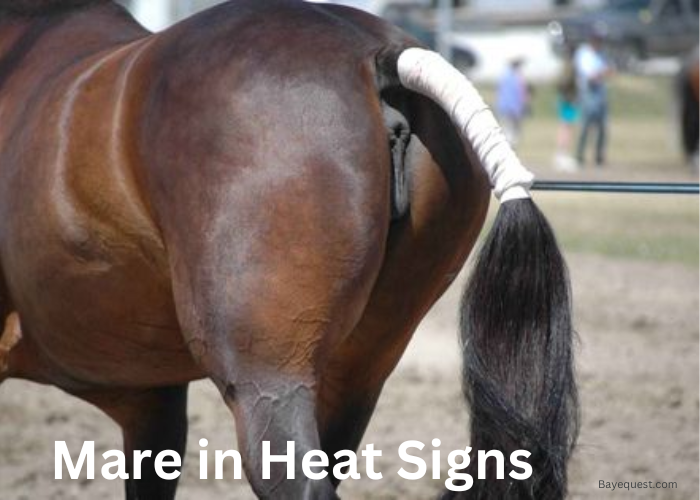When a mare is in heat, she won’t send you a notice. Instead, she shows it with clear signs. Some are subtle, while others are bold and dramatic.
Think of it as a performance where she switches between friendly and feisty. You might notice tail-raising, mood swings, or even sudden changes in behavior.
For horse owners and breeders, recognizing these signs is essential. It helps you manage her needs and avoid unnecessary stress.
Let’s break down the signals so you can handle a mare in heat with ease.
Mare in Heat Signs: Key Takeaway
A mare in heat shows clear signs like frequent urination, tail raising, and vulva winking. She might become restless, vocal, and more interested in stallions. Some mares get moody or aggressive. Recognizing these behaviors helps you manage her better and plan for breeding or keeping peace in the paddock.
What is “Heat”?
“Heat” in mares refers to the period in a mare’s reproductive cycle when she is sexually receptive and fertile, also known as estrus.
During this time, the mare’s body is prepared for breeding, and she exhibits physical and behavioral signs that indicate she is ready to mate with a stallion.
This phase is part of the larger estrous cycle, which lasts around 21 days, with the heat period itself lasting about 5 to 7 days.
Mares usually come into heat multiple times during the breeding season, which generally occurs in the warmer months when daylight hours are longer.
Phases of the Estrous Cycle in Mares
The estrous cycle in mares is a fascinating dance of hormones and behavior. It has two main phases: estrus and diestrus.
Let’s take a deeper look into these phases:
Estrus (Heat phase)
Estrus, or the heat phase, is the period when a mare is sexually receptive and ready to mate with a stallion. This phase lasts between 5 to 7 days, depending on the individual mare and environmental factors like daylight length.
During estrus, the mare’s ovaries develop a dominant follicle, which prepares to release an egg or ovulate. Estrogen levels rise, influencing both the mare’s physical signs and behavior.
Ovulation usually occurs towards the end of the estrus phase, which is the optimal time for breeding a mare.
Diestrus (Non-receptive phase)
Diestrus is the phase following estrus and lasts about 14 to 16 days. During diestrus, the mare is not in heat and will not be receptive to a stallion’s advances.
This phase begins after ovulation when the released egg has either been fertilized or not. The corpus luteum, a temporary endocrine structure that forms in the ovary where the egg is released, starts producing progesterone.
Progesterone helps maintain pregnancy if fertilization occurs. If the mare is not pregnant, the corpus luteum regresses toward the end of diestrus, and progesterone levels drop.
This hormonal change signals the mare’s body to prepare for the next estrus cycle. During diestrus, mares display more stable and less erratic behavior compared to the estrus phase.
Physical Signs of a Mare in Heat
Here are the key physical signs that indicate a mare is in heat:
1. Frequent urination
Mares in heat tend to urinate more often. This is a way of signaling to nearby stallions that they are receptive to mating.
The urine may appear thicker or have a stronger odor. The frequent urination is often accompanied by tail raising, which further exposes the mare’s vulva.
2. Tail raising
A mare in heat will often raise her tail more frequently. This behavior helps release pheromones and allows stallions to detect her readiness to breed.
The tail is held high and moved to the side, exposing the vulva and signaling her interest.
3. Vulva winking
“Winking” refers to the rhythmic opening and closing of the vulva. This is a clear sign that a mare is in estrus.
The winking exposes the clitoris and releases pheromones that attract stallions. It is often seen in combination with tail raising and frequent urination.
4. Swollen vulva
The vulva may appear more swollen or relaxed when a mare is in heat. This swelling is caused by increased blood flow to the reproductive organs, making it a key physical sign of estrus.
The swelling can make the vulva appear more pronounced than usual.
5. Vaginal discharge
A mare in heat may have a slight vaginal discharge. This discharge is usually clear to slightly cloudy and is a natural part of the estrus process.
It can sometimes be noticed on the tail or hindquarters of the mare. The discharge helps in lubricating and preparing the reproductive tract for potential breeding.
6. Flank sensitivity
Some mares may show increased sensitivity around their flanks during heat. When touched or groomed in these areas, they may respond by moving away, kicking, or showing signs of discomfort.
This sensitivity is linked to hormonal changes and readiness for mating.
Behavioral Signs of a Mare in Heat
Here are the key behavioral signs that indicate a mare is in heat:
1. Restlessness and increased activity
A mare in heat often becomes more restless and active than usual. She might pace around the paddock, move around more frequently, or appear agitated.
This restlessness is due to hormonal changes and an increased desire to seek out stallions. It’s a natural way for the mare to express her readiness for mating.
2. Frequent whinnying and calling
Mares in heat tend to vocalize more. They may whinny, nicker, or call out to nearby stallions.
These vocalizations are attempts to attract a mate and communicate their reproductive status.
This increased vocal activity can be quite noticeable and is a clear behavioral sign of estrus.
3. Interest in stallions
A mare in heat will show a strong interest in stallions. She may actively seek out a stallion, stand near him, or position herself in a way that encourages his attention.
If a stallion is present, she might display more affectionate or flirtatious behavior, such as nuzzling or leaning towards him.
4. Changes in appetite
Some mares may show changes in their eating habits when in heat. They might eat less or become more selective with their food.
This change in appetite is often due to the mare’s focus shifting from feeding to seeking a mate. It can be subtle but is worth noting when tracking estrus cycles.
5. Moody or aggressive behavior
Hormonal shifts during heat can lead to mood changes. A mare may become more irritable, moody, or even aggressive towards other horses or handlers.
She might pin her ears back, kick out, or resist handling more than usual. This behavior is often temporary and linked directly to the estrus phase.
6. Standing to be mounted
One of the most definitive signs of a mare in heat is her willingness to stand still to be mounted, either by a stallion or another mare.
This behavior, known as “standing heat,” is the clearest indicator that she is ready to mate. She will stand still, lift her tail, and brace herself to support the weight.
Grading Signs of a Mare In Heat
Curious about how intense your mare’s heat signs are? Check out this table to see if they’re mild, moderate, or severe.
| Sign | Mild | Moderate | Severe |
| Frequent urination | Occasional urination; slightly more than normal. | Regular urination every few minutes when near a stallion. | Constant urination, often even without a stallion present. |
| Tail raising | Raises tail occasionally, with minimal movement. | Frequent tail raising and swishing when near stallions or other horses. | Constant tail raising and holding to one side, regardless of surroundings. |
| Vulva winking | Occasional winking; may not always be noticeable. | Regular winking, especially when interacting with a stallion. | Persistent and frequent winking, even without direct stallion contact. |
| Swollen vulva | Slight swelling, barely noticeable. | Noticeable swelling with slight reddening around the vulva. | Significant swelling, redness, and noticeable protrusion. |
| Vaginal discharge | Minimal or clear discharge; hard to see without close inspection. | Moderate discharge, slightly cloudy or more visible on the tail/hindquarters. | Heavy discharge that is cloudy, thick, or leaves visible marks on the tail. |
| Restlessness | Slight increase in movement; minor pacing or shifting. | Noticeable pacing, circling, or frequent movement around the paddock. | Constant restlessness; unable to stay still, excessive energy and agitation. |
| Whinnying and calling | Occasional, soft whinnying; not overly disruptive. | Regular whinnying and calling, louder when near stallions. | Persistent and loud calling, creating noticeable disturbance. |
| Interest in stallions | Mild interest; stands near stallions occasionally. | Actively seeks stallions, stands closer, and exhibits more nuzzling. | Very strong attraction, persistent attempts to get close to stallions. |
| Changes in appetite | Slight decrease in appetite; eats slower than usual. | Noticeable reduction in food intake; picks at food or shows disinterest. | Significant decrease or complete refusal to eat. |
| Moody or aggressive behavior | Minor irritation; may pin ears back occasionally. | Regular signs of aggression, such as kicking or biting when approached. | Constant aggression, unmanageable behavior, frequent biting, or kicking. |
| Standing to be mounted | Rarely stands still; mild signs of acceptance. | Willingly stands still to be mounted when near a stallion. | Eagerly positions herself to be mounted; remains still and prepared. |
See also: What is a Caslick Surgery in Mares?
How to Track Your Mare’s Estrus Cycle
Tracking your mare’s estrus cycle involves careful observation and record-keeping. This helps in understanding her patterns and managing breeding or behavior more effectively.
Here’s how to do it:
1. Observe behavioral signs
Watch your mare daily for signs of heat. When in estrus, she may raise her tail often, urinate frequently, or show “winking” of the vulva.
She might also become more vocal, restless, or interested in nearby stallions. These behaviors usually peak just before ovulation.
Keep a close eye on these changes, as each mare has her own unique pattern.
2. Monitor physical changes
Physical signs are also key indicators. Feel for changes in the firmness of her cervix or check for vaginal discharge, which may increase during estrus.
Using palpation or ultrasound, a veterinarian can check follicle size and predict ovulation. Regular vet checks help confirm these signs and ensure the mare is healthy.
3. Keep a calendar or cycle chart
Maintain a calendar or chart to track each cycle. Note the start and end of estrus and any distinct behaviors or physical signs.
Recording these details over several cycles helps you predict when she will come into heat next. Most mares cycle every 21 days, but individual timing can vary.
4. Use hormonal tests
For more precise tracking, consider hormonal testing. Blood tests can measure estrogen or progesterone levels.
High estrogen indicates estrus, while high progesterone means the mare is in diestrus. This method is more accurate but requires veterinary assistance and is often used in breeding management.
5. Pay attention to seasonal changes
Mares are seasonal breeders. They are more likely to come into heat in spring and summer when daylight is longer.
In winter, their cycles may become irregular or stop altogether. Keep this in mind when tracking and planning for breeding or managing behavior.
6. Consult with your veterinarian
Work closely with a veterinarian to manage your mare’s reproductive health. They can help with ultrasounds, hormone testing, and overall reproductive care.
Regular check-ups ensure the mare’s cycle is normal and identify any potential issues early.
Managing a Mare in Heat
Managing a mare in heat involves understanding her behavior and making adjustments to ensure her safety and comfort. Here are some key strategies:
1. Create a calm environment
Keep the mare in a quiet, familiar environment to reduce stress. Limit interactions with stallions and other horses that may agitate her.
A calm setting helps prevent unwanted behavior like pacing, kicking, or aggressive displays. If possible, separate her from other horses that might provoke her or be provoked by her behavior.
2. Use safe handling practices
Mares in heat can become unpredictable. Use gentle but firm handling to maintain control.
Always approach her calmly, and be mindful of her body language. Wear protective gear like gloves and sturdy boots, especially if she shows signs of aggression or agitation.
Ensure anyone handling her is experienced and aware of her behavior during estrus.
3. Manage her diet and exercise
Some mares may eat less when in heat, while others might require a higher energy diet due to increased activity levels. Monitor her appetite and adjust her feed.
Regular exercise can help burn off excess energy and keep her calm. Simple activities like lunging, light riding, or groundwork can help manage her mood swings and restlessness.
4. Consider hormonal treatments
For mares with severe heat signs or those used in performance, hormonal treatments like Regumate (altrenogest) can help manage estrus symptoms.
These treatments balance hormone levels, reducing erratic behaviors. Always consult a veterinarian before starting any hormonal therapy to ensure it’s safe and appropriate for your mare.
5. Maintain regular health checks
Regular veterinary checks are essential to ensure no underlying health issues are contributing to unusual behavior during heat.
A vet can perform ultrasounds to monitor follicle development and offer advice on managing extreme symptoms. Keeping track of her cycle also helps predict when she will be in heat again.
6. Monitor her social interactions
If she’s in a mixed-gender herd, monitor her interactions closely. Some mares may become overly flirtatious or aggressive toward other horses.
Adjust her turnout schedule or provide a separate paddock if needed to maintain harmony and prevent injury.
7. Plan for breeding carefully
If breeding is the goal, work with a veterinarian to time it right. Knowing the exact phase of her cycle helps in scheduling artificial insemination or natural cover.
Proper planning ensures a higher chance of successful conception and a smoother breeding process.
How Often Do Mares Go Into Heat?
Ever wondered how often a mare goes into heat? Well, mares go into heat about every 21 days during the breeding season.
This season usually runs from spring to early fall when the days are longer. Each heat cycle, or estrus, lasts around 5 to 7 days.
During winter, many mares stop cycling or their cycles become less regular due to shorter daylight hours.
Mare Heat Symptoms: Conclusion
Understanding a mare in heat is like learning a new language. Her signs speak volumes if you know what to look for.
From subtle winks to bold tail raises, every move tells a story. Knowing these signs isn’t just for breeding; it’s for better care, smoother handling, and keeping peace in the paddock.
So, keep an eye on her signals, jot down those cycles, and be ready to adapt. Because when a mare’s in heat, it’s not just a phase—it’s a conversation waiting to be understood.








